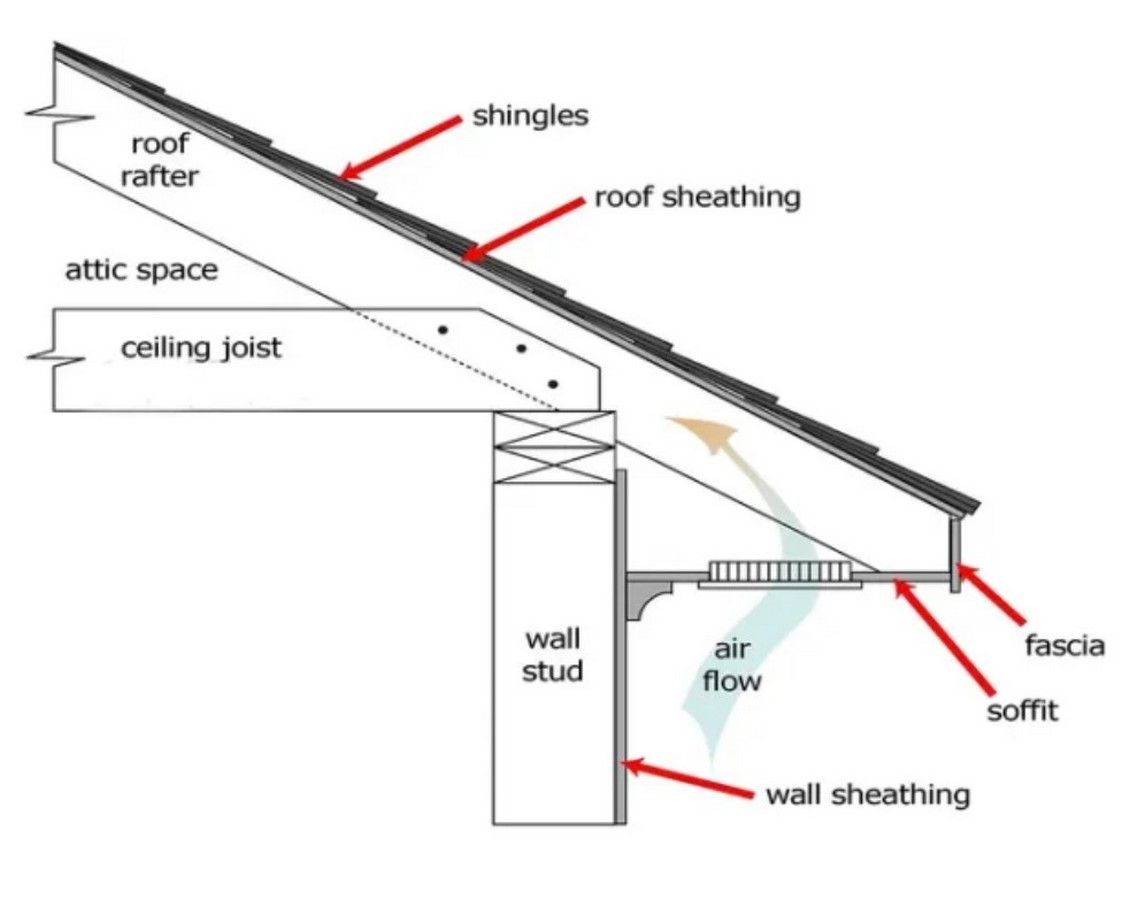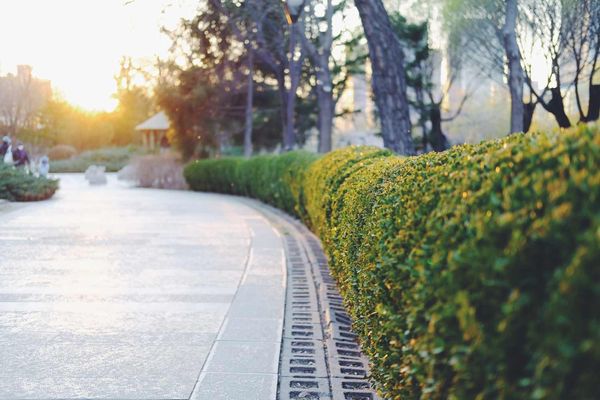Take The Quiz On This Post
Read the post, then take the quiz—test your knowledge and see what you’ve learned!
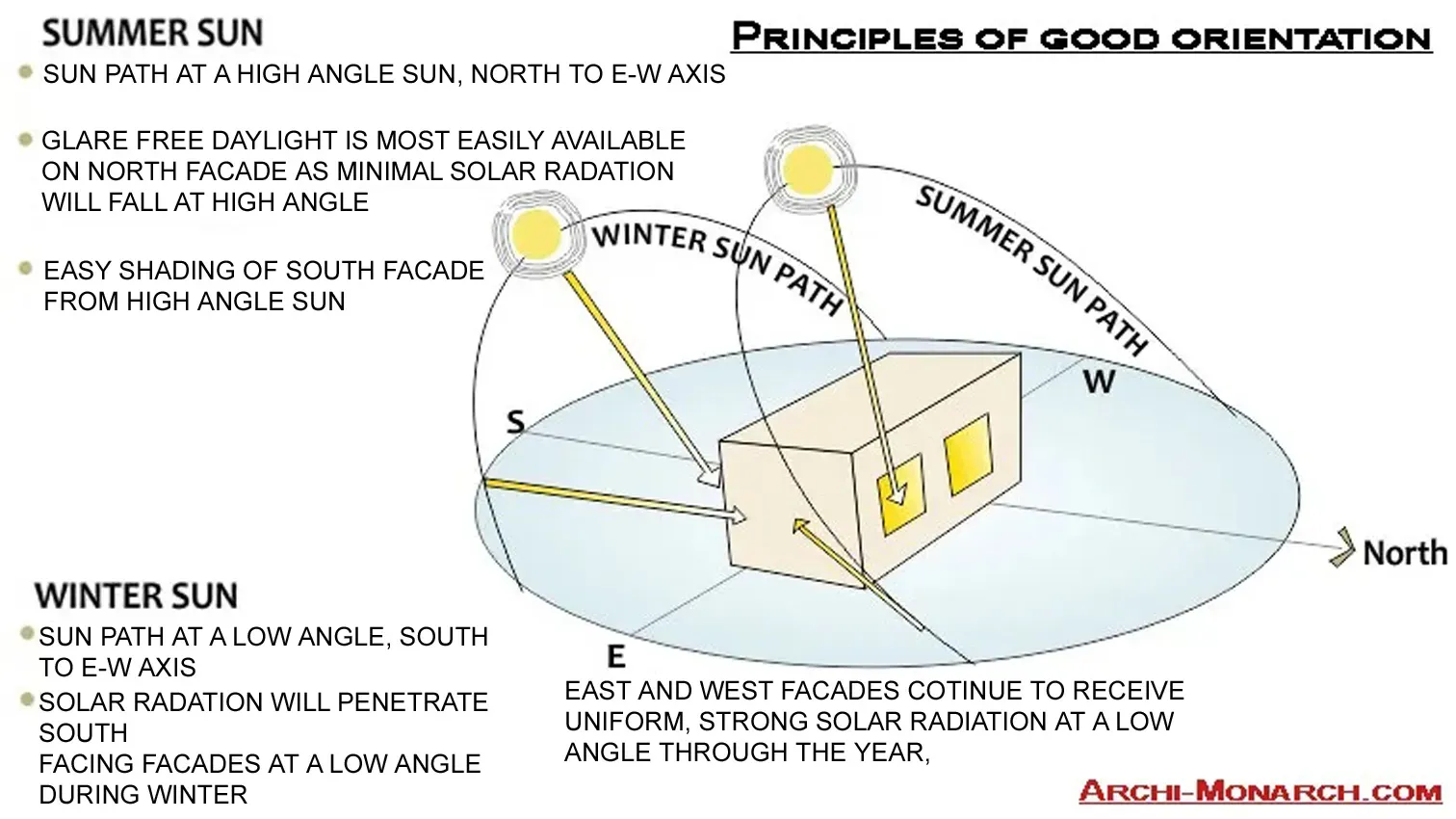
Introduction
Shading plays an significant and important role in the comfort and energy efficiency of your new home. By blocking unwanted sunlight in the summer and allowing it in during the winter, effective shading can help create a comfortable living environment while keeping energy costs low.
In this post, we’ll explore how different shading options, both fixed and adjustable, can be utilised in your home design to achieve optimal results.
We will also discuss important design considerations, such as sun angles, climate zones, and plant selection, to help you make informed decisions that will benefit you for years to come.
With thoughtful shading choices made during the design stage, you can reduce heating and cooling costs and improve the overall liveability of your home. Let's look into the different aspects of shading and how it affects the way you live.

What is Shading?
Shading is the process of blocking direct sunlight to control the amount of heat that enters your home. Effective shading can be achieved using a variety of fixed or adjustable elements, such as eaves, awnings, pergolas, louvres, external blinds, and even fences. Natural elements like trees and shrubs can also provide shading, offering additional benefits like improved air quality and enhanced visual appeal.
The type of shading best suited for your home will depend on your local climate and the orientation of your building. For example, in warmer climates, maximising shading is necessary to keep your home cool, while in mixed climates, the goal is to let in sunlight during winter and block it in summer. In colder climates, minimising shading may be more appropriate to ensure the home remains warm.
Shading is not just about comfort; it’s also about energy efficiency. By reducing heat gain during summer and allowing heat in during winter, shading helps maintain an optimal indoor temperature, reducing reliance on heating and cooling systems.
Types of Shading: Fixed and Adjustable
- Fixed Shading: Includes elements such as eaves, fixed louvres, pergolas, and fences. These are set in place and require no adjustment by the user.
- Adjustable Shading: Options such as external louvres, adjustable awnings, roller shutters, and shade cloth allow for flexibility. These systems can be adjusted based on seasonal changes or daily sun movement to provide ideal levels of shading.
Natural Shading Elements
- Trees and Shrubs: Trees, particularly deciduous ones, provide shading in summer while allowing sunlight in winter when they lose their leaves. Shrubs and other plants can also shade windows and walls, reducing heat load.
By understanding the different types of shading available and how they work, you can make better decisions during the design phase of your home, leading to improved comfort and efficiency year-round.
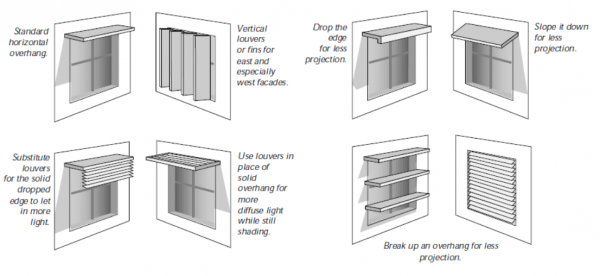
Why Shading Is Important When Designing your New Home
Shading is a fundamental aspect of home design that directly impacts your comfort, energy usage, and the overall liability of your space. Below, we explore the key benefits of incorporating effective shading into your home design.
Summer Comfort and Energy Cost Reduction
Direct sunlight entering your home during summer months can significantly increase indoor temperatures, much like an oven. By shading windows, doors, and other glazed surfaces, you can effectively block up to 90% of unwanted heat, thereby reducing the need for air conditioning and lowering energy bills.
Shading elements such as external blinds, adjustable louvres, and eaves can help prevent excess heat from entering the home, which is particularly important in Australia’s warmer climates. This not only makes the home more comfortable but also leads to substantial savings on cooling costs.
Seasonal Shading Needs
Shading design must consider the seasonal changes in sun angles. In summer, shading should be designed to block high-angle sunlight, while in winter, the goal is to allow lower-angle sunlight into the home for natural warmth. This balance ensures that your home remains comfortable throughout the year while minimising energy consumption.
Reducing Heat Gain Through Glass
One of the main sources of heat gain in homes is through glazed surfaces such as windows and doors. Radiant heat from the sun passes through glass and is absorbed by interior furnishings, which then re-radiate the heat indoors. Shading these glazed areas can prevent heat buildup during summer, while allowing beneficial solar gain in winter when desired.
Using shading devices specifically designed for glass, such as adjustable external louvres or retractable blinds, can help regulate solar heat gain. It is particularly important to consider shading for large expanses of glass, such as sliding doors or skylights, to prevent overheating during the summer months.
Preventing Overheating and Insulation Challenges
Insulation plays a key role in keeping your home comfortable, but without proper shading, it can trap unwanted heat inside during summer, creating an uncomfortable environment. Shading works in conjunction with insulation to prevent this, ensuring that your home remains cool even during extreme heat.
Shading should also complement passive design principles, such as orientation and natural ventilation, to maximise energy efficiency. For example, incorporating shading in north-facing living areas helps optimise solar access and maintain comfort in both summer and winter.
By incorporating effective shading during the design phase, you can ensure a more comfortable living environment, reduce energy consumption, and enhance the overall efficiency of your home.
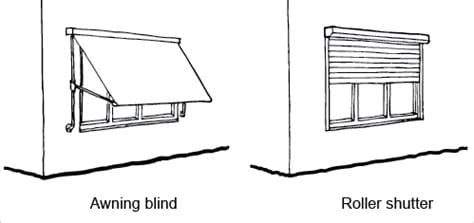
Fixed vs. Adjustable Shading Options
Shading elements can broadly be categorised into fixed and adjustable types, each offering distinct advantages depending on your needs and climate conditions. Below, we explore both options in detail.
Fixed Shading
Fixed shading includes elements that are permanently installed, providing consistent protection from the sun. These are best suited for areas where sun exposure is predictable, such as north-facing façades in most Australian climates. Fixed shading devices are typically low maintenance and do not require any adjustment, making them a convenient option for home owners.
Types of Fixed Shading:
- Eaves: Eaves are one of the simplest and most effective fixed shading methods, particularly for north-facing windows. Correctly designed eaves can block high-angle summer sun while allowing low-angle winter sun, keeping the home comfortable year-round. As a general rule of thumb, the width of eaves should be 45% of the height from the bottom of the window sill to the underside of the eaves.
- Awnings and Pergolas: Fixed awnings and pergolas are commonly used for east- and west-facing windows to protect from low-angle morning and afternoon sun. Pergolas can be covered with shade cloth or climbing plants to further enhance shading.
- Fixed Louvres: Horizontal louvres installed above windows can provide effective shading while maintaining airflow and visibility. These are particularly useful for blocking summer sun while allowing light to enter during winter.
Fixed shading is ideal for home owners looking for a low-maintenance solution that provides consistent shading. However, it is important to ensure that the design of fixed elements is well-planned to avoid blocking desirable winter sunlight.
Adjustable Shading
Adjustable shading allows you to control the level of shading based on the time of year or day, making it a versatile option for optimising comfort and energy efficiency. Adjustable shading is particularly useful for east- and west-facing windows, which receive varying sun angles throughout the day.
Types of Adjustable Shading:
- Adjustable Louvres: Horizontal or vertical louvres can be adjusted to control sunlight entering the home. These are particularly effective on eastern and western façades where sun exposure can vary significantly.
- Retractable Awnings and Blinds: Retractable awnings and external blinds provide flexibility in shading, allowing you to extend or retract them as needed. These are ideal for managing both direct sunlight and glare.
- Shade Cloth and Shade Sails: Shade cloth and sails can be installed over pergolas or outdoor areas and can be removed or adjusted as needed. They are a low-cost, flexible solution for managing sun exposure in outdoor living spaces.
- Sliding Screens and Shutters: These provide an elegant solution for managing shading while maintaining privacy. Sliding screens can be adjusted to block direct sunlight during peak hours, making them an ideal choice for west-facing windows.
Benefits of Adjustable Shading:
- Seasonal Flexibility: Adjustable shading allows you to maximise sunlight during winter for natural heating and block it during summer to keep your home cool.
- Custom Control: You have the ability to control the amount of light and heat entering your home, making it easier to maintain a comfortable indoor temperature.
While adjustable shading provides greater flexibility and control, it does require more user interaction to achieve optimal results. For home owners willing to make small adjustments throughout the year, adjustable shading can significantly enhance the comfort and efficiency of their home.
This is a great video explaining orientation and sunlight design considerations
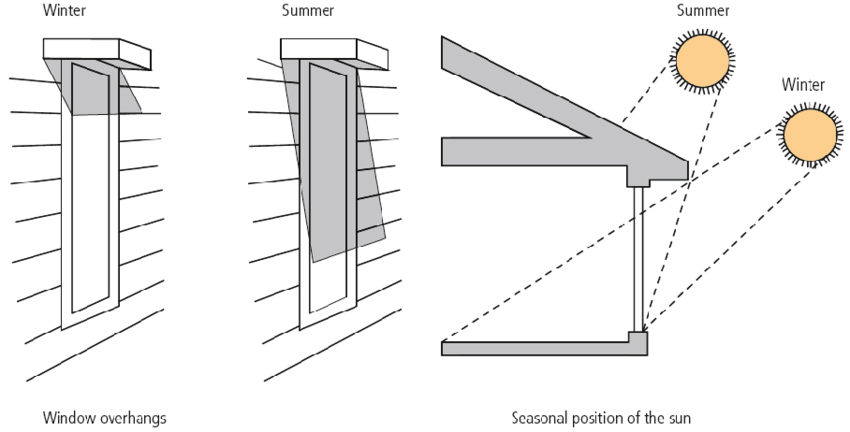
Understanding Sun Angles
The effectiveness of shading in your home is directly related to the angle at which sunlight hits your building. Understanding sun angles is crucial when designing shading solutions, as it allows you to determine the best way to control heat gain and loss throughout the year.
Sun Angles and Their Impact
Sun angles vary significantly between summer and winter, affecting how sunlight enters your home. In summer, the sun is high in the sky, and in winter, it is much lower. Knowing these angles helps in designing shading elements that can effectively block or admit sunlight as needed.
For most of Australia, the ideal orientation for living areas is north-facing, as this allows for the easiest management of solar gain. Correctly designed shading, such as eaves or horizontal louvres, can block high-angle summer sun while allowing low-angle winter sun to enter, providing natural warmth when needed.
Calculating Sun Angles
The angle of the sun at any given time can be calculated based on your location's latitude. This information is important for designing the width and position of shading elements like eaves. The calculation for sun angles at noon during solstices and equinoxes is as follows:
- Equinox: 90° – latitude
- Summer Solstice: Equinox + 23.5°
- Winter Solstice: Equinox – 23.5°
For instance, if you are designing shading for a home in Brisbane (latitude 27.38°S), the sun angle at noon on the summer solstice would be 85.88°, while in winter, it would be 39.88°. These calculations provide insight into how much shading is required to block or admit sunlight during different times of the year.
Tools for Assessing Sun Angles
There are several tools available that can help you determine sun angles for your specific location:
- Sun Angle Apps: Mobile apps that use GPS data can provide accurate sun angle information for your region, making it easier to design appropriate shading solutions.
- Drafting Software: Many designers use drafting software that can calculate sun angles and create shading simulations based on the home's orientation and the topography of the site.
By understanding sun angles and their impact, you can design shading solutions that enhance comfort, reduce energy costs, and ensure your home remains comfortable year-round. This knowledge is especially useful during the planning stage, as it allows you to choose appropriate shading options that align with your home's orientation and climate.
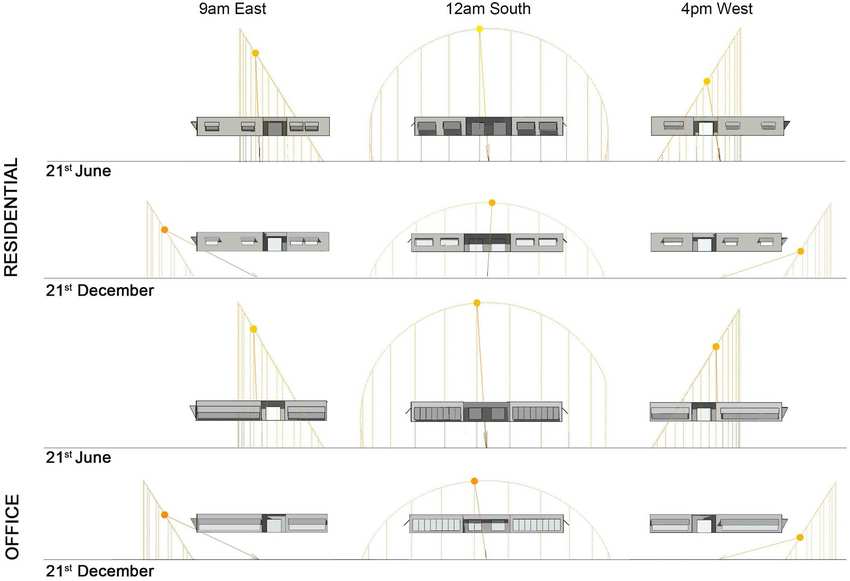
Orientation-Based Shading Design
The orientation of your home plays a significant role in determining the best shading solutions for each façade. In this section, we will explore the recommended shading approaches based on whether your home’s windows and living areas face north, east, west, or south.
North-Facing Façades
For most Australian climates, north-facing façades are ideal for maximising natural light and solar gain during winter, while minimising overheating in summer. North-facing windows receive high-angle sunlight in summer and low-angle sunlight in winter, which makes them easier to shade effectively.
Recommended Shading Solutions:
- Eaves: Properly designed eaves are the simplest and most effective shading option for north-facing windows. Eaves should be wide enough to block high-angle summer sun while allowing winter sun to enter. As a general guide, eaves should extend 45% of the height from the windowsill to the eave bottom.
- Horizontal Projections: Fixed horizontal shading devices, such as awnings and louvres, can also be used to block summer sun and allow winter sunlight.
- Pergolas with Deciduous Vines: Pergolas can provide effective shading for north-facing areas. When covered with deciduous vines, they block summer sunlight but allow winter sunlight through when the leaves fall.
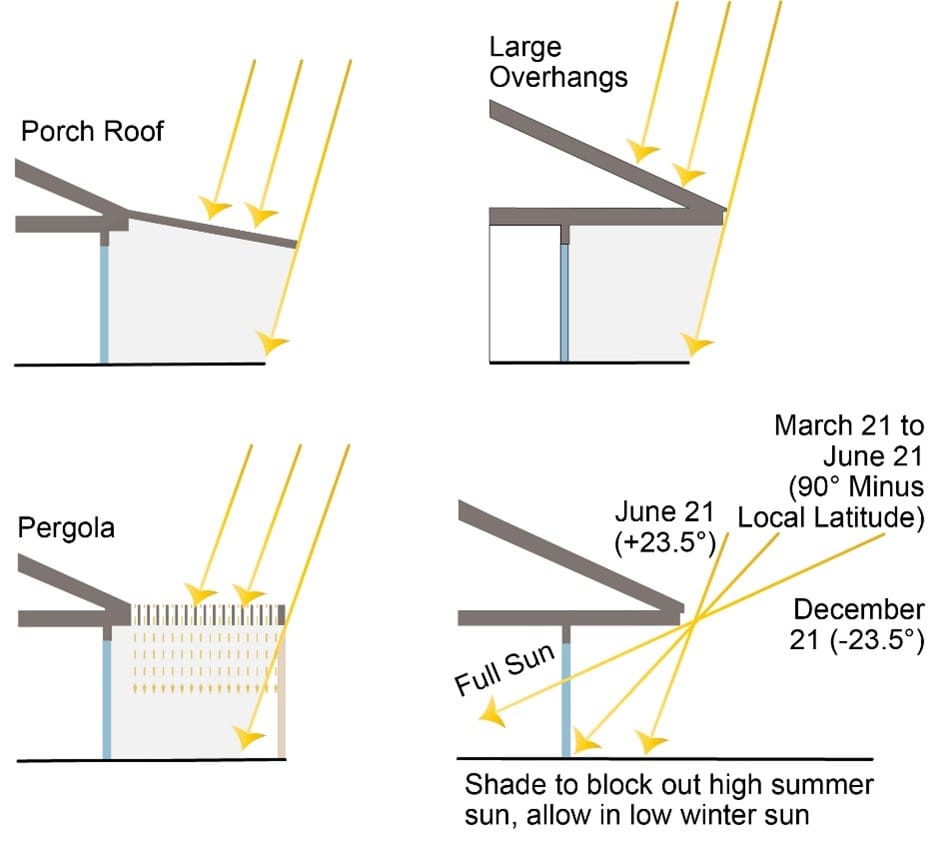
East- and West-Facing Façades
East- and west-facing façades can be challenging to shade due to the low-angle morning and afternoon sun. East-facing windows receive direct sunlight in the morning, while west-facing windows receive afternoon sunlight, which can cause the home to overheat in the late afternoon and evening.
Recommended Shading Solutions:
- Deep Verandas or Pergolas: Deep verandas and pergolas can help reduce direct sunlight entering through east- and west-facing windows. When combined with deciduous vines, they can provide seasonal shading.
- Vertical Louvres or Blinds: Vertical shading structures, such as external louvres or blinds, are effective at blocking low-angle sunlight while still allowing for ventilation and views.
- Sliding Screens: Adjustable sliding screens can be moved to provide shade during the hottest parts of the day, offering flexibility in managing sun exposure.
North-East and North-West Façades
North-east and north-west façades receive a combination of high- and low-angle sunlight throughout the day, making adjustable shading particularly useful for these orientations.
Recommended Shading Solutions:
- Adjustable Louvres: Horizontal or vertical louvres can be adjusted to block direct sunlight during peak hours while allowing light and ventilation when desired.
- Pergolas with Seasonal Plantings: Pergolas with deciduous plantings can be used to provide summer shading while allowing winter sunlight to enter.
South-Facing Façades
South-facing façades receive minimal direct sunlight in most parts of Australia, making shading less of a priority. However, in tropical areas north of the Tropic of Capricorn, south-facing windows may still benefit from some shading to prevent overheating.
Recommended Shading Solutions:
- Evergreen Plantings: Evergreen shrubs or trees can provide year-round shading for south-facing windows in warmer climates.
- Minimal Shading in Cooler Climates: In cooler climates, it is generally best to avoid shading for south-facing façades to allow as much natural light into the home as possible.
Summary of Shading Approaches Based on Orientation:
- North: Use fixed horizontal shading (eaves, awnings) to block summer sun while allowing winter sun.
- East and West: Deep verandas, pergolas, vertical louvres, or adjustable blinds to block low-angle morning and afternoon sunlight.
- North-East and North-West: Adjustable shading (louvres, sliding screens) to provide flexibility throughout the day.
- South: Minimal shading in cooler climates; use evergreen planting in warmer climates.
By tailoring shading solutions to the orientation of each façade, you can create a comfortable and energy-efficient living environment that maximises the benefits of natural sunlight while minimising unwanted heat gain.

Shading Considerations for Different Climate Zones
Shading requirements can vary significantly depending on the climate zone in which your home is located. Australia has diverse climate conditions, ranging from tropical and hot arid to cool temperate zones. Below, we explore shading strategies tailored to suit each of these climate zones.
Hot Humid Climates (Climate Zones 1 & Some Parts of Zone 2)
In hot humid climates, the primary goal is to keep the home as cool as possible by blocking solar heat from all directions while allowing for natural ventilation.
Recommended Shading Strategies:
- Shade the Entire Building: Use wide eaves or a “fly roof” that shades the entire building, including the roof. A fly roof helps keep the building cooler by allowing airflow between the roof and the core structure.
- Shaded Outdoor Living Areas: Deep verandas and covered outdoor areas can help shade incoming air, making the indoor space cooler.
- Landscaping for Shade: Use large trees and dense plantings to provide shade while ensuring airflow is not blocked. Use plantings instead of paving to reduce ground temperature and reflected heat.
Hot Dry Climates (Climate Zones 3 & 4)
In hot dry climates, shading is essential for keeping the home cool during summer, but some solar access is still needed during winter for passive heating.
Recommended Shading Strategies:
- Shading North-Facing Openings: Provide passive solar shading for north-facing windows to block summer sun but allow winter sunlight. Use correctly sized eaves to achieve this.
- Adjustable Screens for East and West: Use deep overhangs or adjustable screens to block morning and afternoon sunlight. Covered balconies or verandas are also effective in shading the living areas.
- Shaded Courtyards: Place a shaded courtyard next to main living areas to act as a cool air well. Plant trees and shrubs to provide additional shade and keep the area cool.
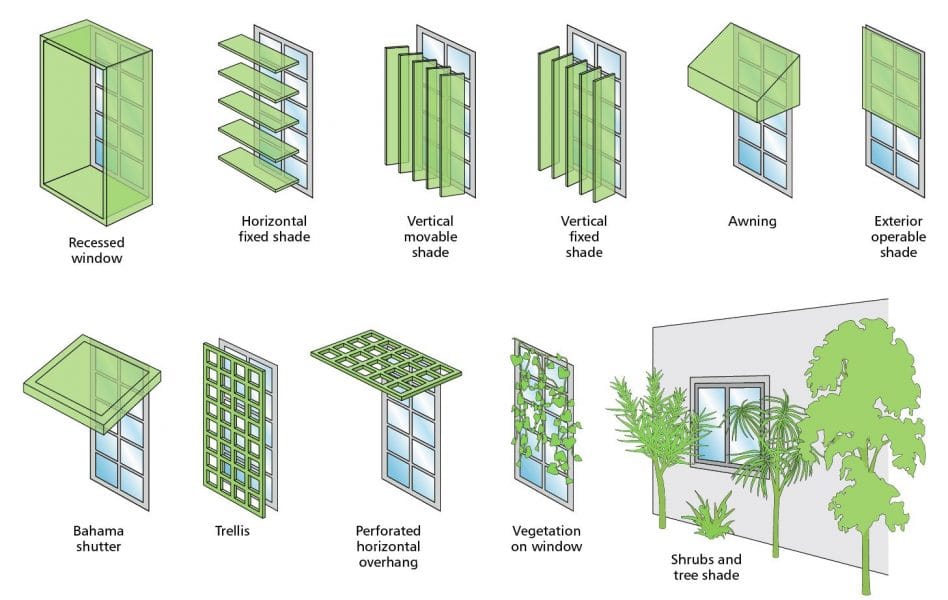
Warm Humid and Warm/Mild Temperate Climates (Climate Zones 2, 5 & 6)
In warm temperate climates, a balance of summer shading and winter solar access is required to maintain comfort throughout the year.
Recommended Shading Strategies:
- Shading North-Facing Openings: Use eaves or adjustable horizontal shading devices to provide shading for north-facing windows in summer while allowing winter sun.
- Deep Overhangs for East and West: Adjustable shade screens or deep overhangs are recommended for the east and west façades to protect from low-angle sun, especially in summer.
Cool Temperate Climates (Climate Zone 7)
In cool temperate climates, maximising winter solar gain is a priority, while some shading is still required during summer.
Recommended Shading Strategies:
- Avoid Shading North-Facing Glass in Winter: Use upward raked eaves to allow full winter solar access. Avoid placing deep covered balconies to the north, as they can obstruct beneficial winter sunlight.
- Deciduous Planting for East and West: Use deciduous trees and shrubs to the east and west. This provides summer shading while allowing winter sunlight through bare branches.
Summary of Climate-Specific Shading Considerations
- Hot Humid: Shade all external openings and walls year-round. Use a fly roof and covered outdoor areas to create cooling breezes.
- Hot Dry: Provide adjustable shading for solar access in winter and shade in summer. Incorporate shaded courtyards for cooling.
- Warm Temperate: Use shading that allows control over seasonal sunlight, such as adjustable louvres or correctly sized eaves.
- Cool Temperate: Minimise shading in winter, and use deciduous planting to provide seasonal flexibility for the east and west.
By understanding the unique shading requirements for your specific climate zone, you can design a home that stays comfortable year-round while keeping energy usage and costs in check. Tailoring your shading approach to your climate conditions is an effective way to ensure your home remains both comfortable and efficient.
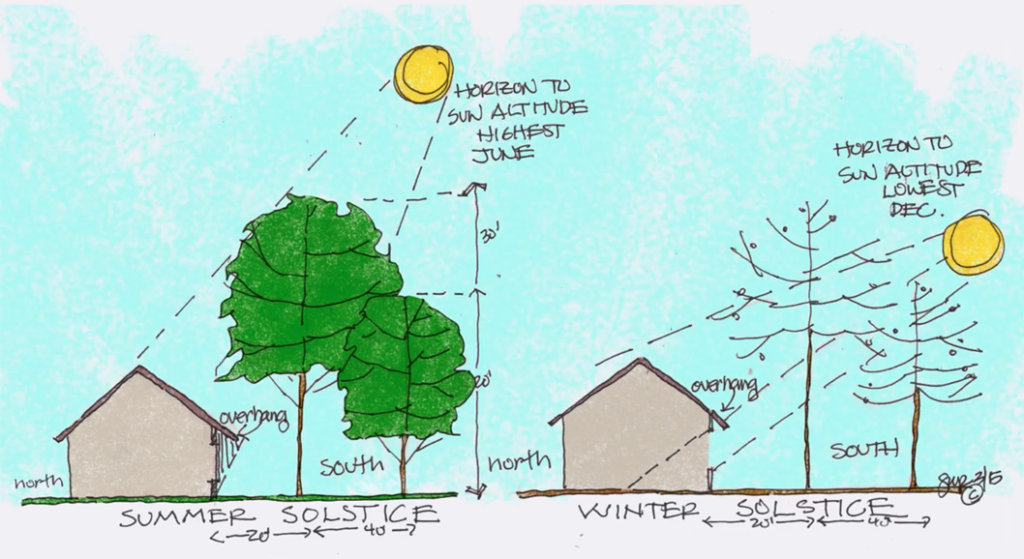
Using Plants for Shading
Plants are an excellent natural way to provide shading for your home, and they come with several added benefits beyond just reducing heat. Plants can improve air quality, provide privacy, create a visually appealing environment, and help block wind, making outdoor areas more comfortable. By strategically incorporating plants into your shading design, you can create a more sustainable and enjoyable living space.
Advantages of Plant Shading
- Low Cost and Low Maintenance: Plants are a cost-effective shading solution that requires little maintenance once established. They also do not consume energy, making them an eco-friendly option.
- Cooling Effect Through Transpiration: Plants help cool the surrounding environment through a process called transpiration, where water evaporates from the leaves, thereby reducing the air temperature around your home.
- Improved Air Quality: By filtering pollutants from the air, plants contribute to a healthier indoor and outdoor environment.
- Aesthetic Appeal: Plants add natural beauty to your home, creating a more attractive and inviting space both indoors and outdoors.
Deciduous vs. Evergreen Plants
The choice between deciduous and evergreen plants will depend on your shading requirements and climate conditions.
- Deciduous Plants: These are ideal for shading north, east, and west façades, as they allow sunlight through bare branches in winter and provide shade with their leaves in summer. Deciduous trees and vines are particularly useful for seasonal shading, giving you the flexibility to control sunlight without manual adjustments.
- Evergreen Plants: Evergreen plants provide year-round shade and are well-suited for hot climates where constant shading is required. They are ideal for planting along east, west, and even south façades to keep your home cool during all seasons.
Design Considerations for Plant Shading
- Trees with High Canopies: Use trees with high canopies to provide shading for roofs and large portions of the building structure. This can significantly reduce the heat load on your home.
- Shrubs for Localised Shading: Plant shrubs near windows and walls to provide localised shading. Shrubs can effectively reduce heat gain through windows and are especially useful for smaller façades.
- Vines and Ground Cover: Vines can be grown on pergolas, trellises, or directly on walls to provide vertical shading. Ground cover helps insulate against summer heat by reducing reflected radiation and keeping ground temperatures cooler.
- Windbreaks: Dense planting can also act as windbreaks, providing additional comfort in outdoor living areas and reducing wind chill around your home.
Choosing the Right Plants
When selecting plants for shading, it is important to choose species that are well-suited to your local climate and soil conditions. Native species are usually the best option, as they are adapted to local weather and require less water and maintenance. Avoid planting trees with invasive root systems close to the house, as they can damage foundations and plumbing.
Examples of Plant Shading Solutions:
- Pergolas with Vines: Grow deciduous vines such as grapevines or wisteria on pergolas to create seasonal shading for outdoor areas. These vines will provide dense shade in summer while allowing sunlight through in winter.
- Tall Trees for Roof Shading: Plant tall trees with wide canopies near the north side of the home to shade the roof. This can reduce the amount of heat entering through the roof during summer months.
- Shrubs for Window Shading: Plant shrubs along east- and west-facing windows to block low-angle sunlight. Choose species that are dense enough to provide good shade while allowing for some airflow.
Maximising the Benefits of Plant Shading
To get the most out of plant shading, it is important to consider their placement and growth characteristics. Match plant height, foliage density, and canopy spread to your shading needs, and ensure that the plants are positioned to provide the right amount of shade during different seasons. Properly selected and positioned plants can enhance shading, cooling, and comfort, making your home more energy-efficient and enjoyable.
By incorporating plants into your shading strategy, you can create a natural and effective solution that not only reduces energy costs but also adds beauty and biodiversity to your home.
Shading for Roof Glazing and Skylights
Roof glazing and skylights are popular features in modern home designs, providing natural light and ventilation. However, they can also be a significant source of heat gain if not properly shaded. Managing sunlight exposure for these features is essential to maintain comfortable indoor temperatures and prevent overheating.
Challenges with Roof Glazing
Roof glazing, such as skylights, is exposed to direct sunlight throughout the day, often receiving more heat than vertical windows. Without appropriate shading, skylights can cause excessive heat buildup, especially during summer, making rooms uncomfortably hot and increasing the reliance on cooling systems.
This problem is compounded by the fact that sunlight entering through roof glazing passes through glass and is then absorbed by furnishings and surfaces, which re-radiate heat inside the home. The re-radiated heat has a longer wavelength, making it difficult to escape back through the glass, resulting in a greenhouse effect.
Shading Solutions for Roof Glazing and Skylights
To effectively manage heat gain and maintain comfortable temperatures, it is essential to use appropriate shading solutions for roof glazing and skylights.
1. External Blinds and Louvres
- External Blinds: Installing external blinds over skylights can effectively block direct sunlight before it reaches the glass. These blinds can be adjusted to control the amount of light entering the space, providing flexibility.
- Louvres: Fixed or adjustable louvres can be installed above skylights to provide shading while still allowing natural light into the room. Adjustable louvres are particularly useful, as they allow you to adapt shading based on the season or time of day.
2. Retractable Awnings and Shade Sails
- Retractable Awnings: Retractable awnings can be installed above skylights or roof glazing to block direct sunlight during peak hours. This solution is flexible, allowing you to extend or retract the awning as needed to control light levels.
- Shade Sails: Shade sails can be installed over sections of the roof that include skylights. They provide a cost-effective solution for reducing heat gain and can be removed during winter to allow more sunlight into the home.
3. Positioning and Design Considerations
- Clerestory Windows: Clerestory windows are positioned high on walls and are often combined with overhanging eaves to provide natural light without excessive heat gain. By positioning clerestory windows to face north and installing eaves that block high-angle summer sun, you can achieve effective shading.
- Double Glazing for Skylights: In cooler climates, double glazing can be used for skylights and clerestory windows to reduce heat loss during winter while still allowing natural light. This helps maintain energy efficiency without compromising on comfort.
4. Adjustable Shade Screens Adjustable shade screens, such as roller shutters or horizontal slats, can be installed over skylights to provide greater control over the amount of sunlight entering the home. These screens can be operated manually or automatically, offering a flexible way to manage solar gain throughout the year.
Importance of Proper Shading for Roof Glazing
Unshaded roof glazing can result in significant heat gain, increasing cooling costs and making living spaces uncomfortable during hot summer months. Effective shading not only prevents overheating but also helps maintain a consistent indoor temperature, reducing the need for artificial cooling and lowering energy consumption.
Skylights can deliver a lot of natural light even when they are small, so it's essential to be conservative with their sizing and ensure that they are properly shaded. This approach will help maintain comfort, minimise energy use, and prevent the 'greenhouse effect' that can occur with unprotected roof glazing.
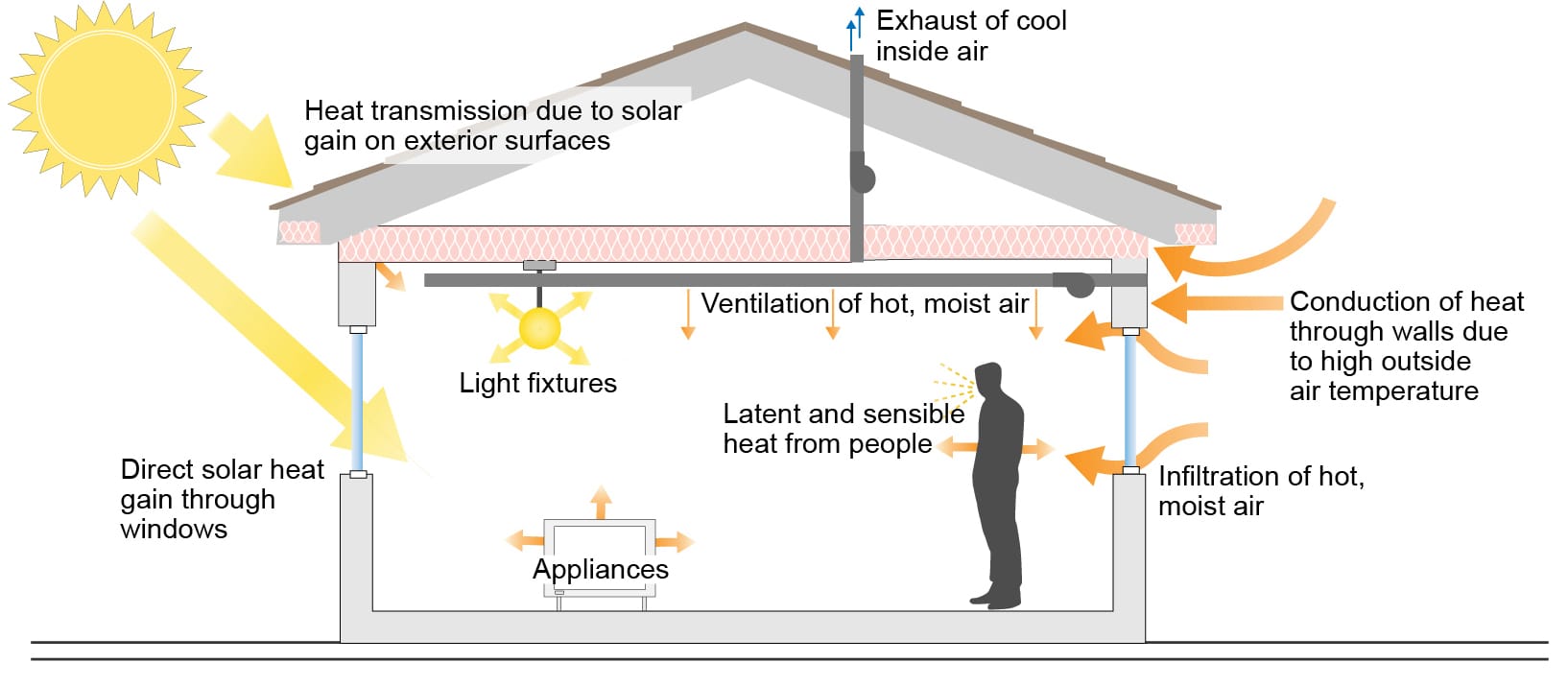
Quality Management and Quality Control in Shading Installation
Ensuring that shading is correctly installed is key to achieving energy efficiency and comfort in your home. Quality management and quality control during the design and installation phases can make a significant difference in the performance of shading elements. This section will provide guidelines on what to consider for effective shading and how to ensure quality throughout the process.
Design Considerations for Shading
Proper design is the foundation for effective shading. During the planning stage, consider the following elements to ensure the shading is efficient and functional:
- Eave Width: Eave width should be determined based on the height of windows and their orientation. For north-facing windows, use the 45% rule to determine the correct width of the eaves. This ensures that the windows are fully shaded during summer while allowing sunlight during winter.
- Orientation-Specific Solutions: Each façade requires different shading solutions depending on its orientation. For example, north-facing façades benefit from horizontal shading, while east- and west-facing façades require deeper shading or vertical louvres to block low-angle sunlight effectively.
- Adjustability: Where possible, incorporate adjustable shading elements, such as external blinds or louvres, to provide seasonal flexibility. This allows for maximum comfort throughout the year by adjusting shading based on sun movement.
Ensuring Long-Term Performance
Shading elements are exposed to various weather conditions, which can impact their performance over time. Proper maintenance is essential to ensure they continue to function effectively.
- Regular Maintenance: Inspect adjustable shading systems, such as blinds, louvres, and awnings, regularly to ensure they are working smoothly. Check for any signs of wear or damage that may require repair.
- Pruning Plants: If you are using plants for shading, regular pruning is necessary to maintain the desired level of shading. Ensure that deciduous trees and vines are pruned seasonally to allow sunlight in winter.
- Cleaning Shading Devices: Clean fixed and adjustable shading elements periodically to prevent dirt and debris from affecting their operation. This is particularly important for louvres and adjustable screens, as debris can obstruct their movement.
Benefits of Quality Shading Installation
By ensuring that shading is properly designed, installed, and maintained, you can achieve the following benefits:
- Increased Comfort: Properly installed shading elements help maintain consistent indoor temperatures, reducing the need for artificial cooling or heating.
- Lower Energy Costs: Shading that effectively blocks unwanted heat in summer and allows sunlight in winter reduces reliance on air conditioning and heating, leading to lower energy bills.
- Improved Durability: High-quality installation ensures that shading devices withstand harsh weather conditions, reducing the need for frequent repairs or replacements.
Conclusion
Shading is an often overlooking but very important component in the design of an energy-efficient and comfortable home. By effectively blocking unwanted solar heat in summer and allowing beneficial sunlight in winter, shading can significantly reduce energy costs and enhance your living environment.
Whether you choose fixed or adjustable shading, or even natural shading through plants, it is essential to consider your climate zone, the orientation of your home, and the specific needs of each façade.
Incorporating shading solutions during the design phase of your home not only improves comfort but also helps to lower your environmental footprint by reducing the need for artificial heating and cooling.
Understanding the importance of shading and making informed decisions about its implementation will contribute to a home that remains pleasant throughout the year, while also being kinder to the environment and more economical to maintain. By considering these measures, you can create a more liveable, sustainable, and attractive space for you and your family.
FAQS
Q1: What is the best type of shading for a north-facing window in Australia?
A1: Fixed horizontal eaves are the best option for north-facing windows. They block high-angle summer sun while allowing low-angle winter sunlight to enter, providing natural warmth when needed.
Q2: How can adjustable shading help reduce energy costs?
A2: Adjustable shading allows you to control the amount of sunlight entering your home. By adjusting shading elements during different seasons or times of the day, you can reduce the need for air conditioning and heating, thus lowering energy costs.
Q3: Should I consider shading for skylights?
A3: Yes, skylights can be a major source of heat gain in summer. Installing external blinds, adjustable louvres, or retractable awnings over skylights can prevent overheating and maintain a comfortable indoor environment.
Q4: What types of plants are best for shading my home?
A4: Deciduous trees and vines are ideal for seasonal shading as they provide shade in summer and allow sunlight through in winter. Evergreen plants are better for year-round shading, especially in hot climates.
Q5: How do I calculate the appropriate eave width for my home?
A5: Use the 45% rule: the eave width should be 45% of the height from the bottom of the window sill to the eave's underside. This ensures that windows are shaded in summer but still receive winter sunlight.
Q6: Is shading necessary for all orientations of my home?
A6: Yes, shading is important for different orientations, although the type of shading will vary. North-facing windows benefit from horizontal shading, while east- and west-facing windows require deeper or adjustable shading to block low-angle sunlight.
Q7: Can shading help reduce my carbon footprint?
A7: Yes, effective shading reduces the need for artificial heating and cooling, which in turn lowers your home's energy consumption and carbon emissions.
Q8: Are there any low-cost shading solutions?
A8: Yes, shade cloth and climbing plants are affordable options that can provide effective shading for outdoor areas, windows, or pergolas.
Q9: How can shading improve my home’s visual appeal?
A9: Shading elements like pergolas, trellises, and plantings add architectural interest and natural beauty to your home, enhancing its visual appeal while also serving a functional purpose.
Q10: What are the risks of poor shading design?
A10: Poor shading design can lead to increased energy costs, reduced comfort, and blocked winter sunlight. It is important to ensure that shading is correctly designed and positioned to meet both summer and winter needs.
Further Reading
